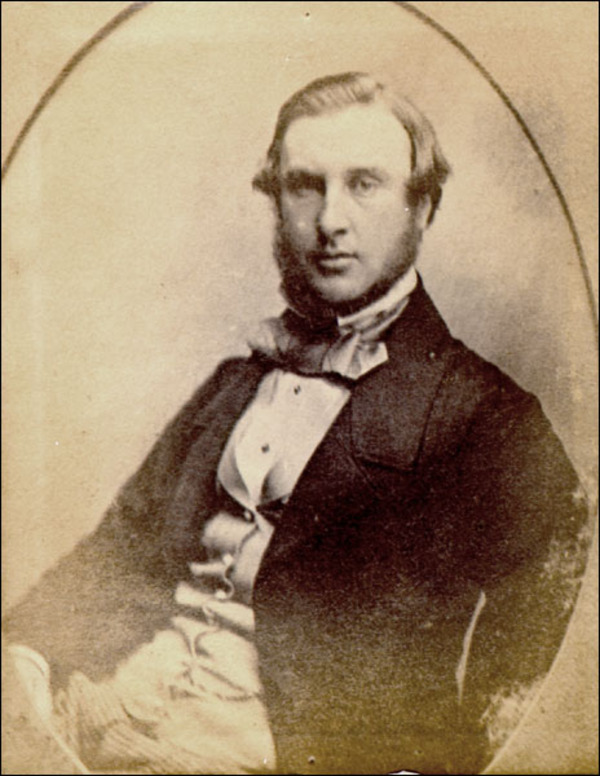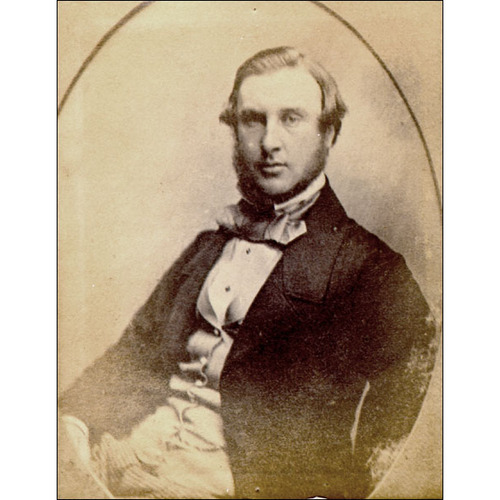
Source: Link
TASKER, PATRICK, merchant and office holder; b. 3 or 4 Dec. 1823 in Greenock, Scotland, third son of James Tasker, a merchant; d. 2 Nov. 1860 in St John’s.
Patrick Tasker came out to Newfoundland in April 1842 to work as a clerk in the family-related business of Hunters and Company. A St John’s branch of the Greenock-based James Hunter and Company, the firm had been active in the Newfoundland fish trade since the mid 18th century and, like all major St John’s fish merchants, it exported fish to southern Europe and the West Indies, imported provisions and fishery supplies for the outports, and outfitted vessels for the spring seal-fishery. Although its stone premises were destroyed in the fire of 9 June 1846 that burnt much of the predominantly frame city, Hunters and Company survived this disaster and was able to resume business.
Throughout the 1840s the company at St John’s had been operated for the Tasker family by a series of shareholder partners. With the withdrawal of George Logan in 1850, the Taskers became sole owners of Hunters and Company. Although young and inexperienced, Patrick Tasker became the new manager; for the first few years he sought the advice of Peter McBride, a Scots merchant of St John’s with more than 25 years’ experience in Newfoundland.
His new status allowed Tasker easy entry into the commercial leadership of the city. In 1850 he was elected to the board of directors of the St John’s Hospital, a seamen’s and fishermen’s hospital which also served the poor and sick of the city. Since 1836 the selection of the 15 directors had been by a quadrennial vote of all the owners and masters of vessels registered at the port of St John’s. Tasker’s election thus shows that he had earned the respect of his older mercantile colleagues. In 1854 he was re-elected and selected as president of the hospital, a position he held for a year; after the introduction of responsible government the following year, the Liberal ministry of Philip Francis Little* assumed complete administrative and financial control of the institution. In the summer of 1854 Tasker was appointed chairman of the newly established group of health wardens, who imposed on a disbelieving populace stringent sanitary regulations to remove the sewage that was so prevalent, especially in the overcrowded streets and narrow lanes in the centre of the city. When a major cholera epidemic broke out later that year, killing more than 500 people, the cleanliness of St John’s undoubtedly helped to keep the number of deaths from rising higher. By the time the epidemic had abated at the end of December, Tasker had won the respect and admiration of all classes in the community.
He was a member of the St John’s Chamber of Commerce from 1852 until his death, and in 1854 served as president of the St John’s Water Company, organized after the fire of 1846 to supply water to the commercial district. An active promoter, in 1854 he became both a member of the organizing committee which established the Union Bank of Newfoundland, the colony’s first successful private banking institution, and a major shareholder in an oil, soap, and candle factory. A director of several local financial and insurance institutions, he was president of both the Newfoundland Marine Insurance Company and the Permanent Loan and Investment Society in 1860.
Like many other merchants, Tasker had not been opposed to the granting of responsible government in 1855. However, he did object to the consequent division of local politics along religious and sectarian lines and to the election of candidates to the legislature on that basis. The St John’s merchants, who were predominantly Protestant (Tasker himself was a Presbyterian), were fearful that their interests would be underrepresented in any elective house. In this sense he typified the city’s mercantile community which saw the encouragement and protection of its interests as crucial to the welfare of the colony, an attitude not surprising in a society where the fishery was the mainstay of the economy.
Tasker’s popularity can be seen in his selection to the executive of several local societies. In October 1855 he was nominated president of the St Andrew’s Society and four months later he was elected president of the non-sectarian Agricultural Society. Further, the growth of the masonic order in St John’s in the 1850s owed much to Tasker’s organizational ability as master in recruiting many of the city’s young professionals and businessmen. By 1856 the freemasons were sufficiently strong financially to secure a long-term lease on one of the best ballrooms in the colony. Two years later they made Tasker the deputy provincial grand master of the order for Newfoundland. In January 1860 he also helped organize the St John’s Volunteer Association, a rifle reserve intended to assist the Royal Newfoundland Companies stationed in the colony, and he was elected captain of the first company.
During the late 1850s Tasker’s business began to decline. In 1857 the company suffered great losses at the fisheries and, despite considerable reductions in the volume of its operations, failed to recover. By May 1860 Tasker owed £2,000 within the St John’s commercial community, and another £8,000 in Scotland, half to his father. What effect, if any, his business misfortunes had on his health is not known. However, while in the process of winding down the company’s activities, he died of a “short but severe illness,” just one month before his 37th birthday. After paying off its debts, Hunters and Company formally closed its doors in 1862 after a century of involvement in the Newfoundland trade.
Patrick Tasker was a leader of a younger generation of merchants and professionals as well as of the entire business community. His funeral procession on 5 November included many of the island’s luminaries such as Thomas* and Charles James Fox* Bennett, Hugh William Hoyles*, Laurence O’Brien*, and the governor, Sir Alexander Bannerman*. In June 1861 the masonic order established a fund in his honour to provide for the education of children of deceased freemasons. The following year the order erected an impressive monument at his grave to commemorate his public service to the city. He was described by a contemporary as having a “gentlemanly deportment, kind and agreeable manner,” while his “honourable nature, rectitude of character and amiable disposition marked him out for a distinctive place in the community.”
AASJ, Edward Morris diary (mfm. copy at MHGA). BLHU, R. G. Dun & Co. credit ledger, Canada, 10: 27. MHGA, Tasker name file. Nfld., Dept. of Health (St John’s), John Joy, “A sketchy survey of Newfoundland health services until the beginning of the 20th century” (typescript, 1971). PANL, GN 2/1, 1854; GN 9/1, 1856. Courier (St John’s), 1862. Newfoundlander, 1842–60. Newfoundland Express (St John’s), 1851–60. Public Ledger, 1842–60. Royal Gazette and Newfoundland Advertiser, 1842–60. When was that? (Mosdell). Gunn, Political hist. of Nfld. Keith Matthews, “A history of the west of England–Newfoundland fishery” (phd thesis, Univ. of Oxford, Oxford, Eng., 1968). Prowse, Hist. of Nfld. (1895). Shannon Ryan, “The Newfoundland cod fishery in the nineteenth century” (ma thesis, Memorial Univ. of Nfld., St John’s, 1971). David Alexander, “Newfoundland’s traditional economy and development to 1934,” Acadiensis (Fredericton), 5 (1975–76), no.2: 56–78.
Cite This Article
Melvin Baker, “TASKER, PATRICK,” in Dictionary of Canadian Biography, vol. 8, University of Toronto/Université Laval, 2003–, accessed December 14, 2025, https://www.biographi.ca/en/bio/tasker_patrick_8E.html.
The citation above shows the format for footnotes and endnotes according to the Chicago manual of style (16th edition). Information to be used in other citation formats:
| Permalink: | https://www.biographi.ca/en/bio/tasker_patrick_8E.html |
| Author of Article: | Melvin Baker |
| Title of Article: | TASKER, PATRICK |
| Publication Name: | Dictionary of Canadian Biography, vol. 8 |
| Publisher: | University of Toronto/Université Laval |
| Year of publication: | 1985 |
| Year of revision: | 1985 |
| Access Date: | December 14, 2025 |



